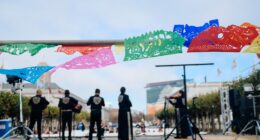In the contemporary music landscape, where digital platforms dominate and consumer preferences shift rapidly, music marketing campaigns have become essential for artists seeking to carve out a niche in a crowded marketplace. These campaigns are not merely promotional tools; they are comprehensive strategies that encompass various elements, including branding, audience engagement, and distribution. The rise of streaming services, social media, and digital content has transformed how music is marketed, making it imperative for artists and labels to adopt innovative approaches that resonate with their target audiences.
The essence of a successful music marketing campaign lies in its ability to connect with listeners on a personal level. This connection is often achieved through storytelling, visual aesthetics, and interactive experiences that invite fans to participate in the artist’s journey. As the music industry continues to evolve, understanding the intricacies of effective marketing becomes crucial for artists at all stages of their careers.
From emerging talents to established acts, the right marketing strategy can significantly impact an artist’s visibility, fan engagement, and ultimately, their commercial success.
Key Takeaways
- Music marketing campaigns are essential for promoting an artist or band and their music to a wider audience.
- Successful music marketing campaign examples include Beyoncé’s surprise album drop and Taylor Swift’s use of social media to engage with fans.
- Effective music marketing strategies include creating a strong brand image, utilizing data analytics, and targeting the right audience.
- Social media is a powerful tool for music marketing, with platforms like Instagram, TikTok, and YouTube being key for reaching and engaging with fans.
- Collaborating with influencers and brands can help expand the reach of a music marketing campaign and create new opportunities for exposure.
Successful Music Marketing Campaign Examples
Revolutionizing Album Launches
Several music marketing campaigns have set benchmarks in the industry, showcasing innovative tactics that have led to remarkable outcomes. One notable example is the campaign surrounding the release of Beyoncé’s self-titled album in 2013. Without any prior announcement or traditional promotional efforts, Beyoncé dropped the album unexpectedly on iTunes. This surprise release strategy not only generated immense buzz but also created a sense of urgency among fans to purchase the album immediately.
The Power of Visual Storytelling
The campaign was further amplified by visually stunning music videos accompanying each track, which were released simultaneously. This approach not only redefined album launches but also demonstrated the power of exclusivity and surprise in music marketing. By combining music and visuals, Beyoncé’s team created an immersive experience that captivated fans worldwide.
Immersive Experiences and Interactive Content
Another exemplary campaign is that of Billie Eilish’s “When We All Fall Asleep, Where Do We Go?” album release in 2019. Eilish and her team employed a multi-faceted approach that included immersive experiences and interactive content. They created a unique website that allowed fans to explore the album’s themes through engaging visuals and sound bites. Additionally, Eilish utilized social media platforms to share behind-the-scenes content, personal anecdotes, and teasers leading up to the release. This strategy not only built anticipation but also fostered a deep connection with her audience, resulting in record-breaking sales and streaming numbers upon release.
Strategies for Effective Music Marketing Campaigns

To craft an effective music marketing campaign, artists must first identify their target audience and understand their preferences. This foundational step involves conducting thorough market research to gather insights into listener demographics, behaviors, and trends. By understanding who their fans are and what they value, artists can tailor their messaging and promotional efforts accordingly.
For instance, an artist targeting Gen Z listeners may focus on platforms like TikTok and Instagram, where short-form video content thrives, while an artist appealing to older demographics might prioritize traditional media outlets or Facebook. Another critical strategy is the development of a cohesive brand identity that resonates with the artist’s music and persona. This identity should be reflected across all marketing materials, including album artwork, social media profiles, and promotional videos.
Consistency in branding helps establish recognition and trust among fans. For example, the visual aesthetic of an artist’s social media presence should align with the themes of their music, creating a unified experience for listeners. Additionally, artists should consider leveraging storytelling techniques to convey their journey, struggles, and inspirations through their marketing efforts.
This narrative approach can foster emotional connections with fans and encourage them to engage more deeply with the artist’s work.
Utilizing Social Media in Music Marketing Campaigns
| Platform | Metrics | Results |
|---|---|---|
| Likes, Shares, Comments | Increased engagement and reach | |
| Followers, Likes, Stories views | Visual content performs well | |
| Retweets, Mentions, Hashtag use | Real-time updates and interactions | |
| YouTube | Views, Subscribers, Watch time | Video content drives engagement |
Social media has revolutionized music marketing by providing artists with direct access to their audiences. Platforms like Instagram, Twitter, TikTok, and Facebook allow musicians to share updates, engage with fans, and promote their work in real-time. One effective strategy is to create a content calendar that outlines regular posts leading up to an album release or concert tour.
This calendar can include a mix of promotional content, behind-the-scenes glimpses, personal stories, and interactive posts that encourage fan participation. Engagement is key on social media; artists should actively respond to comments and messages from fans to foster a sense of community. For instance, live Q&A sessions or Instagram Stories polls can create opportunities for direct interaction.
Additionally, utilizing features like Instagram Reels or TikTok challenges can help artists reach wider audiences by encouraging fans to create content related to their music. The viral nature of these platforms can significantly amplify an artist’s reach and introduce their work to potential new listeners.
Collaborating with Influencers and Brands
Collaborations with influencers and brands can significantly enhance an artist’s visibility and credibility within the music industry. Influencers often have dedicated followings that trust their recommendations; thus, partnering with them can introduce an artist’s music to new audiences who may not have discovered them otherwise. For example, when Lil Nas X released “Old Town Road,” he collaborated with various TikTok influencers who created dance challenges around the song.
This grassroots approach not only propelled the song to viral status but also showcased how influencer partnerships can drive engagement and streaming numbers. Brand collaborations can also be mutually beneficial; artists can align themselves with brands that share similar values or aesthetics. For instance, a clothing brand might partner with an artist for a limited-edition merchandise line that reflects the artist’s style while promoting both entities simultaneously.
Such collaborations can create unique marketing opportunities that resonate with fans on multiple levels. The key is for artists to choose partnerships that feel authentic and align with their brand identity to maintain credibility among their audience.
Leveraging User-Generated Content in Music Marketing

User-generated content (UGC) has emerged as a powerful tool in music marketing campaigns. By encouraging fans to create and share content related to an artist’s music—such as dance videos, covers, or fan art—artists can foster a sense of community while amplifying their reach. UGC not only serves as authentic endorsements but also allows fans to feel more connected to the artist’s journey.
For example, when Drake released his hit “In My Feelings,” he encouraged fans to participate in the #InMyFeelingsChallenge on social media platforms like Instagram and TikTok. The challenge went viral, resulting in millions of user-generated videos that contributed to the song’s success. To effectively leverage UGC, artists should create specific campaigns or challenges that inspire fans to participate actively.
Providing incentives such as giveaways or featuring fan-created content on official channels can further motivate engagement. Additionally, showcasing UGC in marketing materials—such as music videos or promotional posts—can validate fans’ contributions while enhancing the overall narrative of the campaign.
Creating Engaging Content for Music Marketing Campaigns
Engaging content is at the heart of any successful music marketing campaign. Artists should focus on producing high-quality visuals and compelling narratives that capture attention and evoke emotions. Music videos remain a staple in this regard; they serve as a visual representation of an artist’s work while allowing for creative storytelling.
For instance, Sia’s “Chandelier” music video not only showcased stunning choreography but also conveyed deep emotional themes that resonated with viewers. Beyond traditional music videos, artists can explore various content formats such as vlogs, live performances, behind-the-scenes footage, and interactive experiences like virtual concerts or listening parties. These formats provide opportunities for deeper engagement with fans while allowing artists to showcase their personalities beyond their music.
Additionally, incorporating elements like lyric videos or animated visuals can cater to different audience preferences while keeping content fresh and exciting.
Measuring the Success of Music Marketing Campaigns
To determine the effectiveness of a music marketing campaign, artists must establish clear metrics for success from the outset. Key performance indicators (KPIs) may include streaming numbers, social media engagement rates, ticket sales for live events, merchandise sales, and overall brand awareness. Utilizing analytics tools available on various platforms can provide valuable insights into audience behavior and preferences.
Regularly assessing these metrics allows artists to adapt their strategies in real-time based on what resonates most with their audience. For instance, if a particular social media post garners significant engagement compared to others, it may indicate a successful approach worth replicating in future campaigns. Additionally, gathering feedback from fans through surveys or direct interactions can provide qualitative insights that complement quantitative data.
In conclusion, navigating the complexities of music marketing campaigns requires a multifaceted approach that combines creativity with strategic planning. By understanding their audience, leveraging digital platforms effectively, collaborating with influencers and brands, utilizing user-generated content, creating engaging materials, and measuring success through defined metrics, artists can enhance their visibility and foster meaningful connections with fans in an ever-evolving industry landscape.









